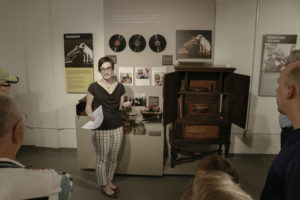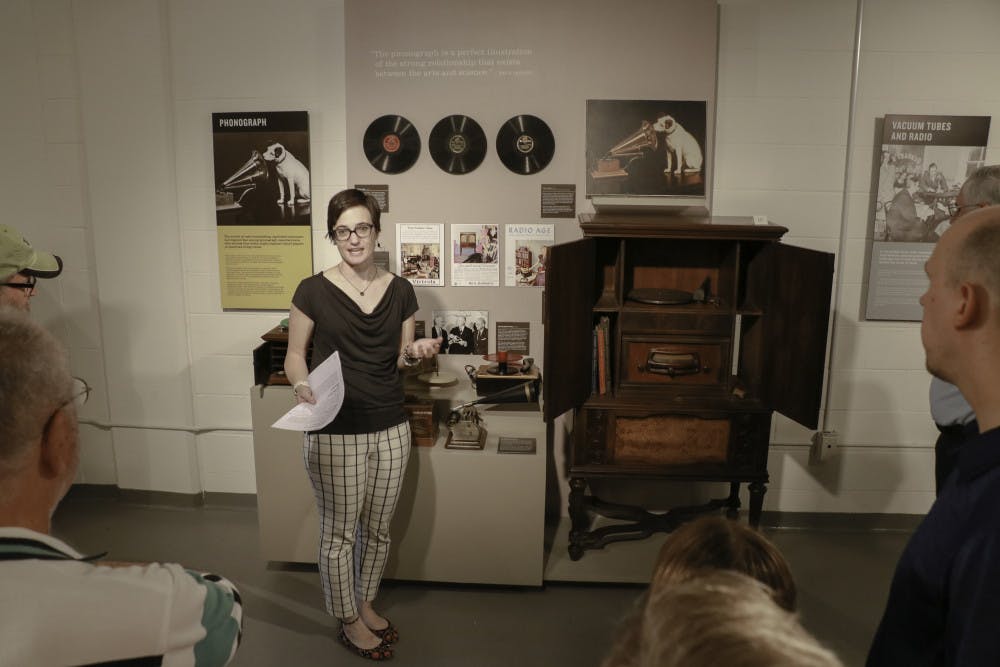By Miguel Gonzalez
News Editor
While most students were busy moving into their residence halls, exhibit attendees in Roscoe West Hall were riding the waves.

The College’s Sarnoff Collection hosted a guided tour on Wireless Word, a pop-up radio exhibit, on Sunday, Aug. 26 in Roscoe West Room 204.
The exhibit showcased radio artifacts from The Radio Corporation of America between 1910 to the late ’80s in celebration of National Radio Day, which was Aug. 20. Florencia Pierri, the Sarnoff Collection’s curator, guided a discussion about numerous radio artifacts.
Pierri started the tour by demonstrating the Crystal set, the first popular type of radio introduced in 1913. According to Pierri, the Crystal set brought radios to a wider audience and laid the foundation for radio enthusiasts. During the 1920s, enthusiasts would purchase parts and instruction books to assemble their own radios.
Pierri followed up by presenting the first radio of RCA’s iconic radiola series, the Aeriola Sr. Receiver radio, Type RF. Introduced in 1921, the radio sold for $75. The device was not successful because RCA did not include necessary accessories such as vacuum tubes, antennas and batteries.
Pierri then showed the radio’s successors, the Radiola II and the Radiola III. The Radiola II, introduced in 1923, proved to be RCA’s first smash hit because of its distance range. Using more than one vacuum tube, the Radiola II had an impressive 2000 mile range. During the 1920s, it was commonly referred to as the radio music box, according to Pierri.
In the following year, RCA created a budget version of the Radiola II with the Radiola III. According to Pierri, it sold for $35.
While RCA had several successful radios, it also encountered struggles as radio broadcasts were still developing.
“In 1923, radio was great, but if you didn’t have headphones it wasn’t useful,” Pierri said. “The only radio stations at the time were in Pittsburgh and New York City. Those radios only broadcasted 30 hours a week.”
Pierri then shifted the visitor's attention to the Radiola 13. The device, distributed in 1928, was the first radio that operated on an alternating circuit. According to Pierri, it was an important step in radio technology because the device was plugged into an outlet and no longer relied on batteries.
The device also played a crucial role in RCA’s marketing. During the 1920s, radios were usually placed in basements because of their heaviness and dull appearance. But with the Radiola 13, RCA pushed consumers to use their products in living rooms.
Pierri then paused the tour to discuss RCA’s most significant business decision. In 1929, RCA acquired the Victor Talking Machine Company. According to Pierri, RCA was able to utilize the company’s large manufacturing plant in Camden, New Jersey and market the company’s iconic mascot, Nipper the dog, to improve its sales. As a result, RCA was no longer dependant on General Electronic for materials.
According to Pierri, the manufacturing plant was the largest in Camden at the time, employing 10,000 people. The majority of employees were women, because RCA knew women were unable to unionize like men could.
Pierri emphasized how new the radio industry was in the early 20th century. Unlike today’s world, where customers subscribe to satellite radios such as Sirius XM, the radio market was widely open during the ’20s.
“You didn’t need to buy a license to listen to radio broadcasts,” Pierri said. “It was like The Wild West. You could listen to all the music. Ads didn’t appear until 1923.”
Pierri explained ubiquitous radios were despite the failing economy during the Great Depression. During the 1930s, RCA manufactured 9,000 radios per day.
“People wanted radios even during the Great Depression,” Pierri said. “People were known to sell their beds before radios. Radios were considered to be people’s connection to the world.”
After World War II, RCA faced financial difficulty as more consumers wanted televisions. According to Pierri, RCA countered by introducing transmitter radios in 1955.
RCA’s transmitter radios were portable and durable. According to Pierri, RCA illustrated the radios’ durability by dropping them off a helicopter in advertisements. By the ’70s, RCA marketed these radios as “pockette” radios to attract younger customers. Pierre showed a colorful design by holding the RZG 105Z, which had a patriotic red, white and blue color scheme.
“RCA was trying to be hip at the time because radios were perceived as media parents only enjoyed,” Pierri said.
Pierri concluded the tour by discussing the decline of RCA during the ’80s, and emphasized RCA’s inability to challenge emerging companies such as Sony and International Business Machines.
“In 1971, David Sarnoff passed away. By the following decade, his son, Robert, made many bad managerial decisions. RCA’s spiral continued as RCA’s computer department could not compete against IBM and SONY’s technologies in the 1970s,” Pierri said.







